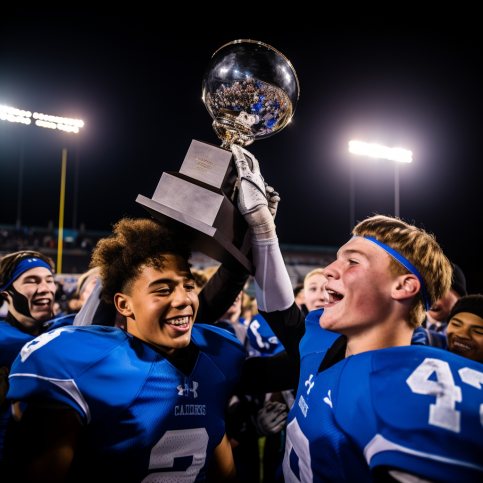ASU’s self-imposed postseason ban: The latest chapter in an epic administrative failure
Questions left unanswered after school kneecaps its football program before season opener
The NCAA’s infractions committee will provide the epilogue in its own time. However, Arizona State University has published the final chapter of the Herm Edwards era. President Michael Crow and athletic director Ray Anderson co-wrote this tale of horror and hubris, destruction and mayhem.
On Sunday, five days before the start of the 2023 season, the Sun Devils announced a self-imposed postseason ban, surprising coach Kenny Dillingham and the players and leaving a slew of questions that the decision’s authors, Crow and Anderson, have no intention of answering.
They will conceal themselves behind what the school described as “our membership obligation (to the NCAA) to maintain the confidentiality of the matter.” Crow and Anderson, as a result, “will not be commenting further at this time.”
Their responsibilities to the ASU players are secondary.
Our thoughts on the heinous decision…
— With the entire Edwards era now available for scrutiny, we’re left with a rhetorical question: Why did Arizona State hire him in the first place, then implement the disastrous ‘New Leadership Model’?
Obviously, because Edwards was a close friend and former business partner of Anderson’s.
There are no other explanations, motivations, or justifications. In fact, it has never been.
This was a personal high for the athletic director, and it wreaked havoc on the football program.
Anderson’s decision will be remembered as a monumental administrative blunder.
— Why wasn’t the postseason ban imposed prior to or early in the 2022 season, when Edwards was still in charge?
Given the alleged evidence dossier turned over to the NCAA, this would have been appropriate on several levels. Instead, after a sluggish start, the Sun Devils fired Edwards, hired an interim coach, and staggered through a wasted year ripe for a bowl ban.
With the removal of the 2023 postseason, that level of waste has now more than doubled.
According to the evidence, Anderson’s refusal to self-impose last year was motivated by a desire not to tarnish Edwards’ legacy further.
Then he backed up their friendship by reaching a $4.4 million separation agreement with Edwards.
That’s correct. During the COVID dead period, the school paid $4.4 million to a coach whose program was under NCAA investigation for major recruiting violations.
Obviously, Crow approved the settlement. But we’re left wondering: Where was the fiduciary duty to the university? Spending $4.4 million on a buyout when they could have spent zero for terminating Edwards with cause strikes us as fiscally irresponsible.
— Why announce the postseason ban five days before the season opener — and after school had already begun? What had changed by August 27 that hadn’t been noticeable in the spring, before the transfer portal closed?
Crow and Anderson waited this long on purpose so that the players couldn’t leave in a group. Was it a cold, calculated decision to leave the players with no options?
Given the lack of logical alternatives, it’s a reasonable question to pose.
— Another reasonable question is why the postseason ban was imposed at all.
The NCAA signaled a newfound aversion to issuing bowl bans as part of its penalty matrix in its ruling on the Tennessee recruiting scandal last month:
“Normally, a case of this magnitude would justify and necessitate a postseason competition ban.” However, these are not ordinary times in college sports. The landscape has changed in numerous ways and will continue to do so. In terms of the infractions program, the membership has expressed a desire to move away from penalties that affect student-athletes who were not involved in violations.”
Instead of issuing a bowl ban for an unprecedented number of recruiting violations, the NCAA simply fined Tennessee $8 million and allowed the football team to compete in regular season and postseason play.
And yet, with the Tennessee ruling still hot off the NCAA press, Arizona State has decided to self-impose a bowl ban.
As a result, the evidence against Edwards and his staff appears to be massive.
Which begs the question: Why didn’t ASU impose the bowl ban during the 2021 or 2022 seasons, when Edwards was still in charge?
If Anderson and Crow knew Thor’s hammer was coming and believed a proactive approach would mitigate the impact, why didn’t they take that step before this week?
— Understandably, smoke billowed from Dillingham’s nostrils when he addressed the media following practice on Sunday. He was clearly caught off guard by the impending postseason ban and must now lead his team through the fall with no postseason carrot.
Dillingham understands that this decision undermines his players’ — and prospective players’ — faith in Arizona State and the culture he is attempting to establish.
He is well aware that it will provide rival programs with ample material to recruit against the Sun Devils.
He is aware of the long-term consequences.
And he now realizes that his boss, Anderson, cannot be trusted. Not for a second.
— As Anderson and Crow hide behind their “obligation” to the NCAA to maintain “confidentiality,” we are left with so many questions, and the reality is that they may never provide satisfactory answers.
However, their actions since the scandal broke in the summer of 2021 indicate a desire to prioritize a personal relationship over the best interests of the school and the athletes.
Administrative accountability does not exist in the Arizona State football program.
Anderson is still employed, with a contract that pays him approximately $1 million per year (plus bonuses) until the winter of 2026.
Edwards? He has $4.4 million in his bank account and is back at ESPN as a studio analyst.
As one industry source put it about the timing of the ASU announcement, “it’s utterly unconscionable.”
Because that’s how Anderson and Crow roll, the only victims of this horrible story are the innocent.





